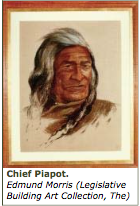
Piapot (Payepot) was born to a Cree mother and an Assiniboine father in 1816; shortly after his birth his parents died of smallpox. When he was a small boy, he and his grandmother were captured by a band of Sioux, with whom he lived for the next fourteen years until he was rescued by a Cree war party. In 1830 Piapot became chief. He would lead his people in the last major inter-tribal engagement between the Cree and the Blackfoot on the Oldman River in 1870. After this last battle Piapot made his home in the Qu’Appelle Valley. In 1874, when Treaty 4 was negotiated, Piapot was not present: he was away hunting, and as a result did not learn of the negotiation until after it had been signed. In 1875 he met with Treaty Commissioner William Christie, and after seeking guarantees that he would receive farm instructors, mills, more tools, and medical assistance, he signed an adhesion to Treaty 4. However many of the terms Piapot believed he had negotiated would not appear until Treaty 6 in 1876.
Piapot was part of a group of chiefs who wanted a large reservation surveyed for them in the Cypress Hills area. Canada, however, feared the concentration of a large Indian population in one area, and refused. As a result, Piapot was eventually forced to select a home in the Qu’Appelle Valley, where a reserve of fifty-four square miles was surveyed—well short of the 110 square miles his band was entitled to under the Treaty. Throughout the rest of his life Piapot continually challenged the Canadian government by holding ceremonies and by fighting to have Treaty rights recognized. He died on his reserve in 1908.
Rob Nestor

